(9 pm. – promoted by ek hornbeck)
I know that this is sort of a subject about which I do not write often, since I am, for the life sciences, more botanist than zoologist. But this topic was by special request from a friend, that friend indicating that zebras are her or his favorite animal. So Zebras it is.
Actually, as I began doing research on them, I also became fascinated with them as well. Not only are they extremely handsome animals, they have an extremely complex diversification into diverse subspecies, something that I vaguely knew but was very interested to learn more about as the research continued.
Zebras are uniquely African, except of course for those that have been taken away from there. They are very much allied with horses and asses, but with some twists. One of the most interesting thing is that the accepted scientific name for them is likely erroneous, but that comes later.
I suppose we should first look at the lineage insofar as the scientific name goes for them, since it is very convoluted. All three species and the several (authorities do not agree on the number of them) are of the same genus as horses and asses, Equis, Latin for “steed”, more than horse, but they are sort of interchangeable. Now it gets complicated as far as the taxonomy goes, because there are two subgenera, Hippotigris and Dolichohippus. Note that both contain the Latin root hipp, meaning horse as well. The subgenus name is usually not given as part of the entire Latin name. For example, Grévy’s Zebra, Equus grevyi of the subgenenus Dolichohippus, has the same lingo as Plains Zebra, Equus quagga, of the Hippotigris subgenenus. But it gets even more convoluted!
The accepted Latin name for all of the subgenus Hippotigris is either that for the Plains Zebra, Equus quagga with a third subspecies name, or Mountain Zebra, Equus zebra also with a third subspecies name. The complicated part is that the species name is that of the sole known extinct species! They should be named differently, but because of protocol, biological scientific names stand with the first valid (as valid as known at the time) until overwhelming support from the community is given to change it. That happens sometimes, and even genera have been changed or created to accommodate new data. Not yet for the zebra.
Since we have already mentioned the quagga, (Equus quagga quagga) we might as well start with this extinct subspecies. Here is a picture of one of the last known ones, taken in 1870 at the London Zoo:
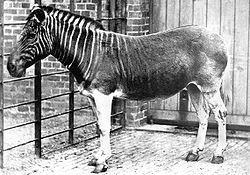
It is thought that they were extinct in the wild in the late 1870s, and the last one in captivity died in 1883. However, modern DNA analyses indicate that the quagga is but a variety of the Plains zebra, Equus quagga (previously called Equus burchelli). Breeding programs to “reinvent” the quagga are now underway, taking Plains zebras that are lightly striped in the rear and selectively breeding them to produce a stable markings pattern similar to that of the quagga. Recent births resemble the photographs and the few preserved specimens, but just because an animal looks like an actual quagga does not necessarily make it a proper quagga.
The “common” zebra is the Plains zebra, Equus quagga, and the half dozen or so subspecies of it, some of them more common than others. These are what we think of when we say “zebra”, and all of the subspecies tend to have vertical stripes from neck to hindquarters, when they become horizontal. They all have horizontal stripes in their legs. Their manes tend to be shorter than typical for domestic horses.
The actual color of zebras is black (they shaved one at a zoo), and the white hair covers the black skin. This makes sense, because in the harsh African sun they would be prone to sunburn if the skin were pale. The muzzles are also dark brown or black. The large population have stripes on their undersides, but some of the subspecies do not. Here are a few pictures of some of the stripe schemes for them. Note that the quagga was the most different of all of the subspecies as far as stripes go.
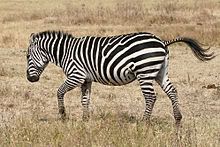
Plains zebra, Equus quagga
Note that the stripes come all the way down to the hoof.
One of the subspecies is Grant’s zebra, Equus quagga boehmi. This is the most populous of all of the subspecies and of all zebras in general. They tend to have short manes and bold stripes, and some of the northern populations have no mane to speak of at all. They also have striped on the belly and down the hoof. Here is a picture:
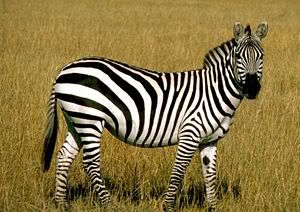
Grant’s zebra, Equus quagga boehmi
Here is the current range for Grant’s zebra:
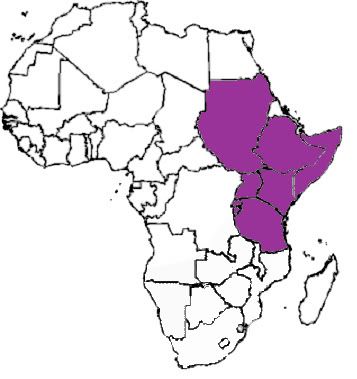
Selous’ Zebra, Equus quagga borensis, as paler than the aforementioned ones and is quite endangered. I could not find to be what I term a reliable picture of one, but here is its current range:
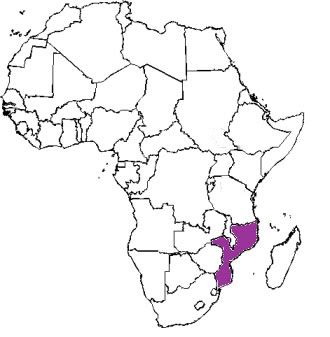
Burchell’s zebra, Equus quagga burchellii was thought to be extinct, but it looks like some still exist but are endangered. Their stripes are very light in color, and sort of look like a quagga. They have no stripes on the bellies and none or very light ones on their legs.
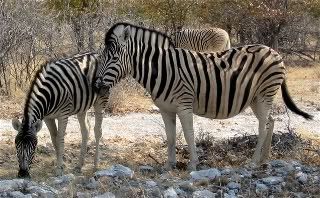
Burchell’s zebra, Equus quagga burchellii
Since they have only been rediscovered, no distribution map is available.
Chapman’s zebra, Equus quagga chapmani, is different in appearance from the others, having “shadow” stripes between its darker ones. It is not endangered, and I could not find a distribution map for it. The Damara zebra, Equus burchelli antiquorum, is not recognized by all authorities. It looks a lot like a Chapman’s and may be another name for it.

Chapman’s zebra, Equus quagga chapmani
Here is a range map for the Chapman’s:
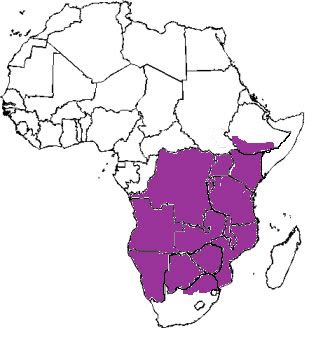
Crawshay’s zebra, Equus quagga crawshayi is a fairly obscure subspecies of the Plain’s zebra and occurs only a small range. It is boldly striped and looks pretty much like a typical Plain’s one.
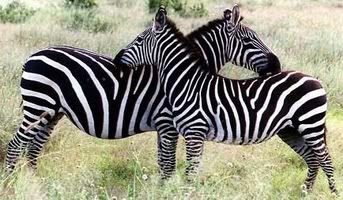
Here is a range map:
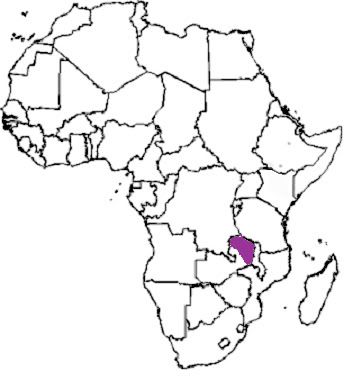
Now we go to the Mountain zebra species, Equus zebra. It has two additional subspecies which we shall discuss in a minute. Mountain zebras are, as the name indicates, are not plains creatures but rather prefer higher elevations, up to about 2000 meters, or a little over 6000 feet. They have small, sharp hooves to facilitate climbing and a tuft of hair on the tailtip. Here is a picture of a typical one:
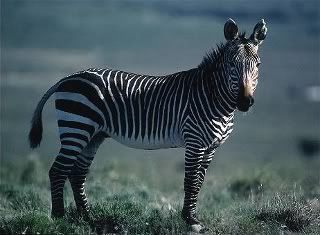
Mountain zebra, Equus zebra
Here is a distribution map:
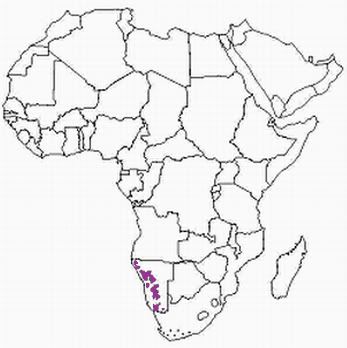
One thing about mountain zebras that is different than plains ones is the dewlap, or loose skin, on the neck.
The Cape mountain zebra, Equus zebra zebra, has thick black stripes and is near extinction, with only a few hundred individuals known. They are being cared for and have been reintroduced into the wild in a few locations. Here is what they look like:
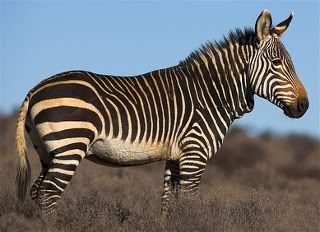
Cape mountain zebra, Equus zebra zebra
The other subspecies is the Hartmann’s Mountain Zebra, Equus zebra hartmannae. It has thin stripes rather than thick ones. I was not able to find much information about them except that they are about as threatened as the Cape kind.

Hartman’s mountain zebra, Equus zebra hartmannae
The last kind of zebra is the Grevy’s zebra, Equus grevyi. It was the first zebra discovered by Europeans and looks more like a mule than a horse. It is also endangered, with fewer than 4000 individuals surviving. The stripes are quite different than those of other zebras, go clear to the hoof, and are absent on the belly.
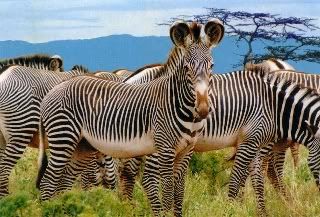
Here is a range map:

Most zebras are harem animals, with a single stallion taking around a dozen, give of take, mares that live together and sometimes share caring for the foals. A couple of species are solitary, with a stallion having a territory and the mare being left to fend for herself (and for the foal, when is born) after mating.
Why in the heck do zebras have stripes? There are many hypotheses, the most plausible of which have to do with hiding. One says that the vertical stripes make them seem to disappear in the grass, and another indicates that all of those individuals en masse look like a really big animal that predators are loathe to attack. Another says that the stripes confuse tsetse flies, and that is sort of supported by experimental data but I could not find a link to it. There are others, but I find the first one the most plausible.
I said that lots of varieties of zebras are highly endangered, and the quagga is already extinct. The quagga was probably hunted to extinction for its skin and meat, and that is also one of the driving forces behind the reduced numbers for extant varieties, much as befell the American bison except they were rescued. However, there is another pressure on zebras that the bison did not have and that is loss of habitat. With African human populations soaring, except for preserves and parks there are simply few places that they can go.
Yes, people DO eat zebra flesh, just as horsemeat is eaten in several places in Europe. This puts lots of pressure on them as the population balloons as well, so unless something is done about population control the zebra, once numbering in the millions, may end up being like the quagga, just a stuffed museum piece. Of course, their hides are also quite valuable because of their decorative value.
That about does it about zebras. I knew little about them except what I had learnt as a child until I did the research for this piece, and I thank the person who requested that I use this as a topic tonight.
Well, you have done it again! You have wasted many more einsteins of perfectly good photons reading this camouflaged piece. And even though the Republicans who said that we did the Libyan intervention too fast, then said that we did not do things fast enough, and now say all kinds of contradictory things admit to themselves that they just want to be against anything the the administration is for when they read me say it, I always learn much more that I could possibly hope to teach in writing this series. Thus, please keep those comments, questions, corrections, and other feedback coming. Tips and recs are also highly appreciated.
Warmest regards,
Doc, aka Dr. David W. Smith
Crossposted at
Daily Kos, and

3 comments
Author
a striped subject?
Warmest regards,
Doc
Author
I very much appreciate it.
Warmest regards,
Doc